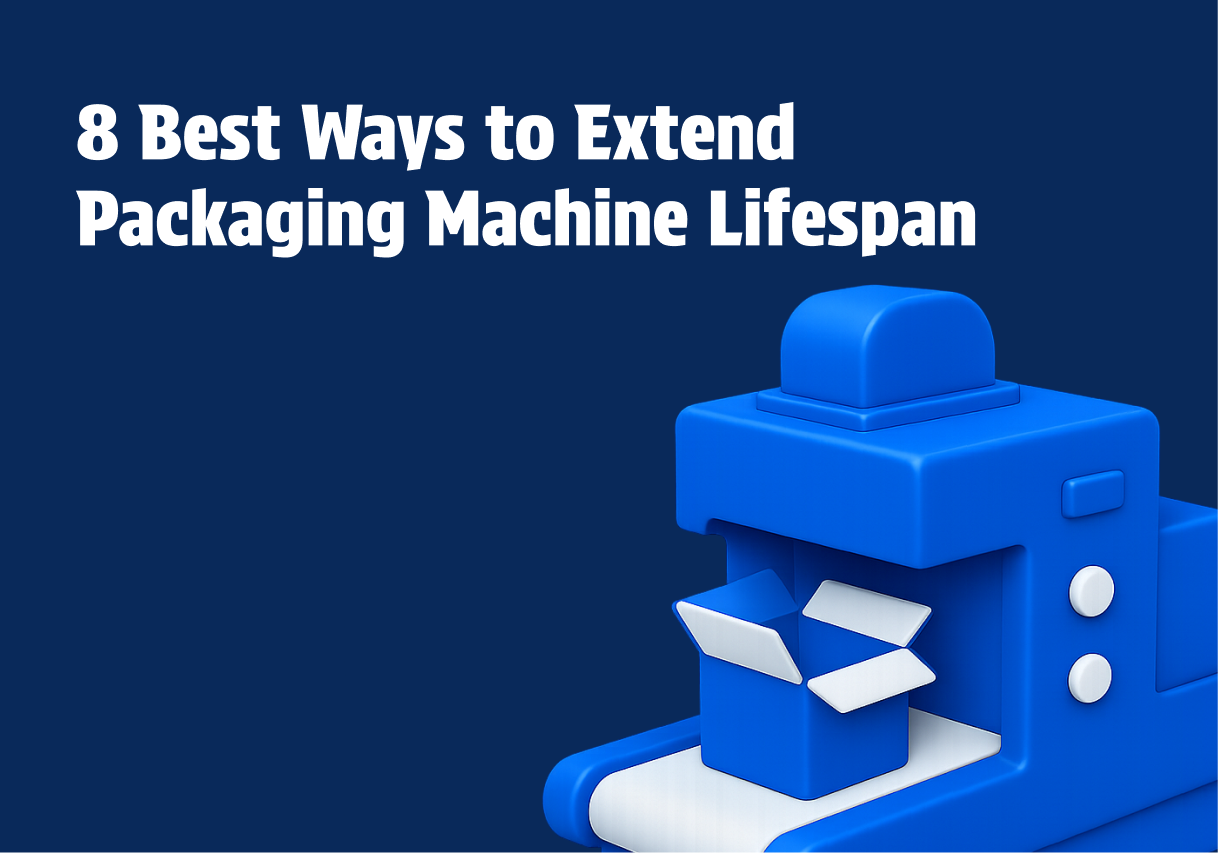Packaging machines are the backbone of modern manufacturing and e-commerce operations, ensuring that products are safely and efficiently prepared for shipment. With the global packaging equipment market set to reach USD 50 billion by 2027, these machines are a major investment. Frequent breakdowns from poor maintenance can lead to costly repairs and production delays.
Therefore, extending the lifespan of these machines is not just about preserving capital investment but also about maintaining consistent throughput and quality. By adopting a systematic approach to machine care, businesses can enhance performance, minimize unexpected repairs, and extend the overall lifespan of their equipment.
This blog will guide you through the best ways to extend the packaging machine's lifespan with service contracts to reduce downtime and maximize ROI.
A quick overview:
- Regular maintenance, cleaning, and lubrication keep machines running smoothly and reduce wear on key components.
- Well-trained operators and technicians ensure correct usage, prevent errors, and maintain consistent performance.
- High-quality parts and smart monitoring help prevent breakdowns and support long-term machine reliability.
- Proper installation, controlled environments, and timely upgrades protect machines and extend their lifespan.
What is a Packaging Machine?
A packaging machine is specialized industrial equipment that helps you automate various stages of the packaging process, including filling, sealing, labeling, wrapping, and palletizing. These machines are crucial in high-volume production environments such as pharmaceutical, healthcare, food, beverage, and e-commerce sectors.
By automating repetitive tasks, packaging machines enhance speed, precision, and consistency, helping you reduce human error and increase overall productivity. Whether it’s a case sealer, strapping machine, or pallet wrapper, each device requires specific care to maintain optimal performance.
Why Regular Maintenance is Crucial for Packaging Machines?
Regular maintenance is essential for ensuring your packaging machines operate efficiently and reliably. Here’s why it matters:
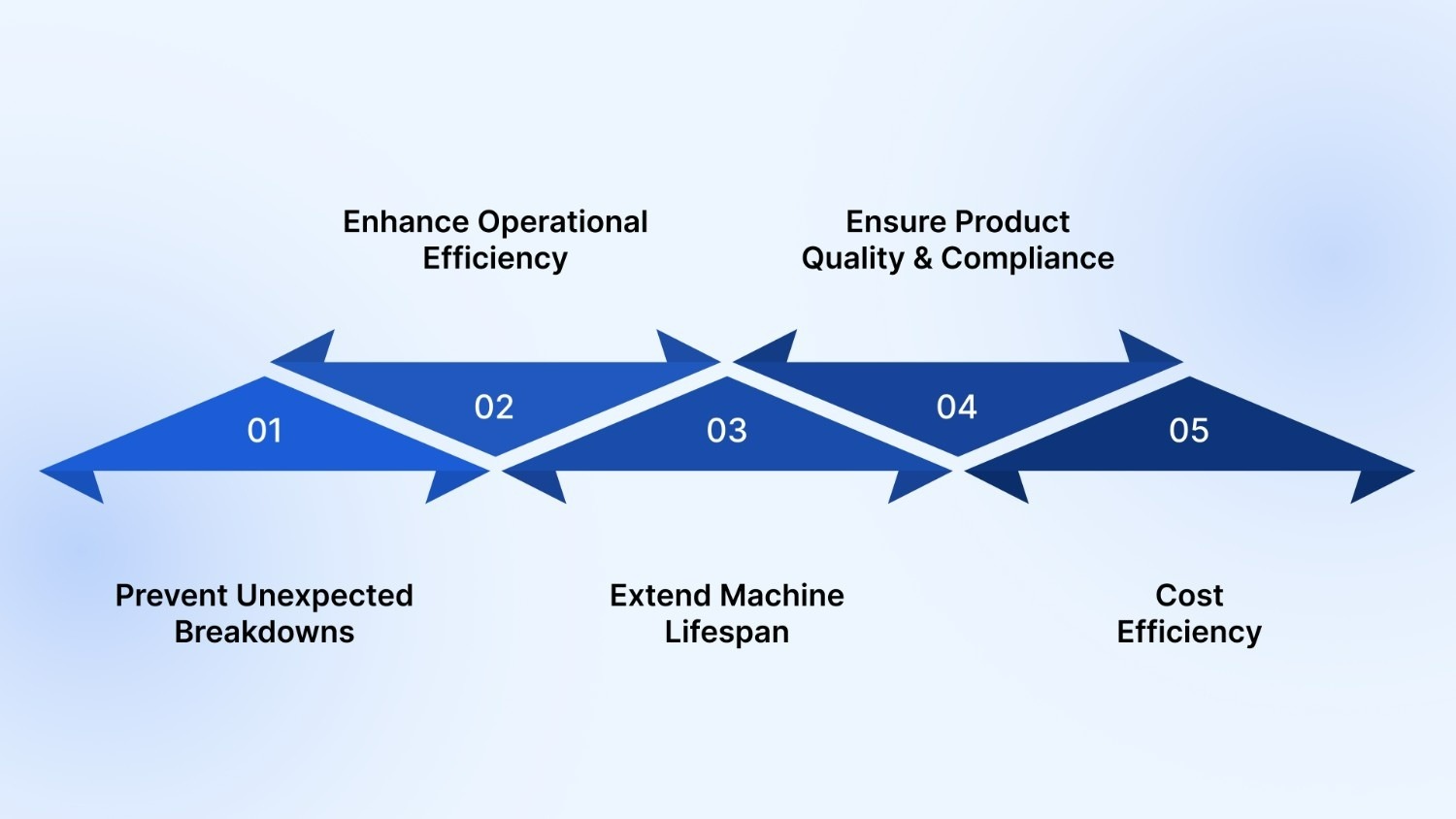
- Prevent Unexpected Breakdowns: Routine inspections and servicing help you catch potential issues early, avoiding costly downtime and emergency repairs.
- Enhance Operational Efficiency: Well-maintained machines help you maintain smooth operations, consistent output, and reduce production bottlenecks.
- Extend Machine Lifespan: Regular care reduces wear and tear on motors, belts, and sensors, helping your equipment last longer.
- Ensure Product Quality and Compliance: Properly maintained machines help you maintain accuracy and performance, which is crucial for industries like pharma and healthcare.
- Cost Efficiency: Preventive maintenance reduces the need for major repairs and replacements, saving both time and operational expenses over the machine’s lifecycle.
In the following section, let’s explore the most effective strategies to extend your packaging machine’s lifespan and improve long-term reliability.
Also Read: How to Choose the Best Packaging Equipment for Your Business?
8 Proven Strategies to Extend Packaging Machine Lifespan
Optimizing packaging machine lifespan requires a combination of technical care, operator competence, and operational foresight. Here are the key strategies that industrial professionals can implement:
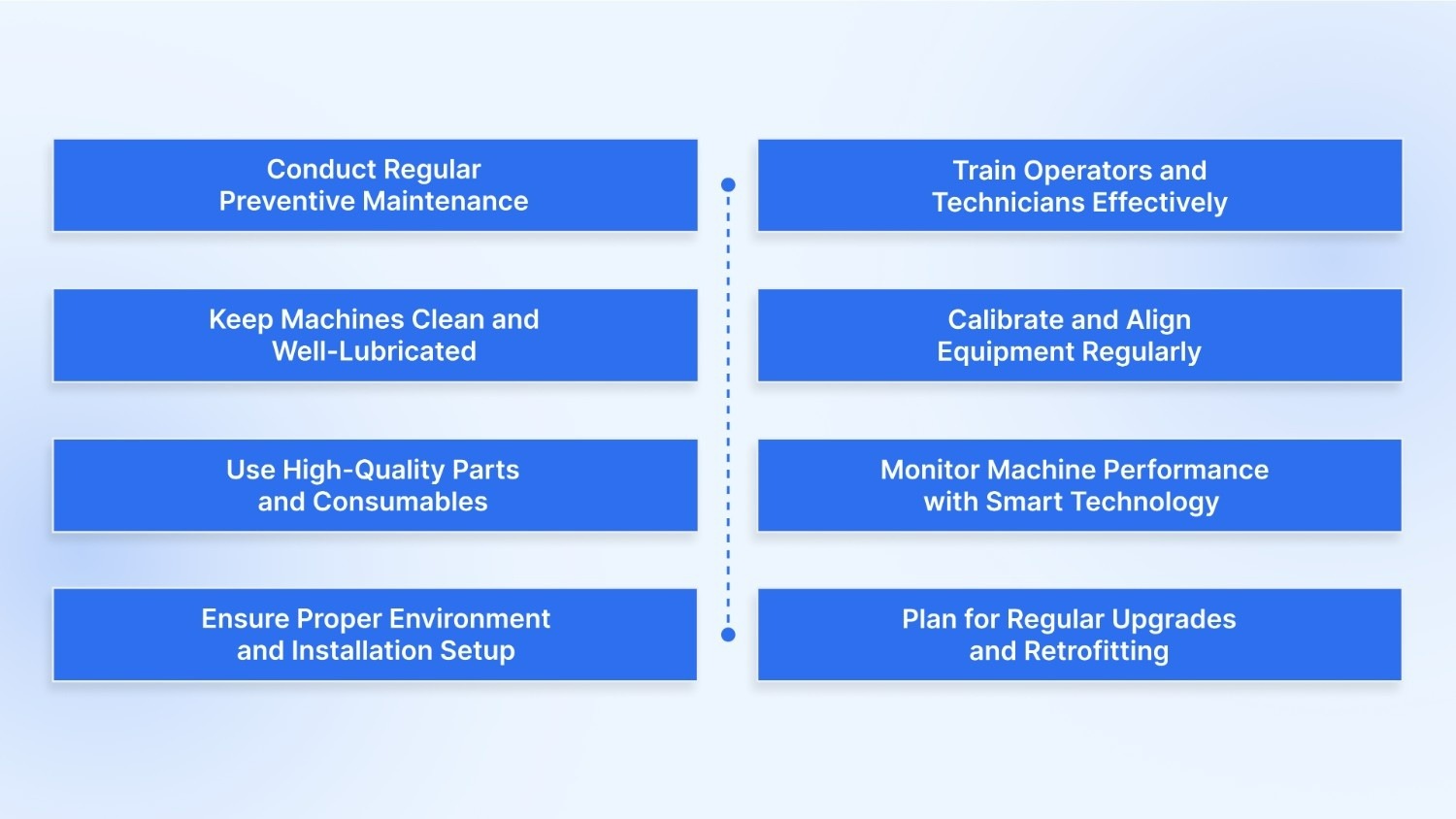
1. Conduct Regular Preventive Maintenance
Regular preventive maintenance is the foundation for long-lasting machinery. It helps you detect and fix potential issues before they cause breakdowns, keeping your operations smooth and reliable.
Tips:
- Schedule Weekly or Monthly Inspections: Check belts, gears, bearings, and electrical systems to spot early signs of wear.
- Follow a Lubrication Routine: Apply recommended lubricants to moving parts as per manufacturer guidelines to reduce friction and prevent overheating.
- Replace Worn Components Promptly: Swap out aging parts before they affect your machine’s performance and avoid costly downtime.
Maintaining a disciplined preventive maintenance schedule helps you reduce emergency repairs and ensures your machines run at peak efficiency.
2. Train Operators and Technicians Effectively
Properly trained personnel play a critical role in machine longevity. Understanding how to operate, troubleshoot, and maintain equipment correctly minimizes human error and enhances performance.
Tips:
- Train Your Operators: Educate machine operators on correct usage, including start-up, shutdown, and emergency procedures.
- Certify Your Technicians: Make sure your maintenance staff receive manufacturer-specific training for repairs, calibration, and troubleshooting.
- Regular Refresher Courses: Conduct periodic skill updates to reinforce best practices and adapt to technological upgrades.
Skilled operators and technicians help you minimize errors, extend your equipment’s life, and improve overall productivity.
3. Keep Machines Clean and Well-Lubricated
A clean machine is a healthy machine. By keeping dust, debris, and residue away and lubricating moving parts properly, you can prevent unnecessary wear and improve performance.
Tips:
- Daily Cleaning: Remove dust, packaging residue, and debris from conveyor belts, rollers, and sensors to prevent blockages.
- Lubrication Schedule: Apply lubricants to gears, bearings, and chains according to manufacturer recommendations to reduce friction and wear.
- Check for Contamination: Ensure lubricants and cleaning agents are compatible with machine materials to prevent corrosion.
Maintaining a clean and well-lubricated machine prevents mechanical issues, enhances performance, and supports longer operational life.
4. Calibrate and Align Equipment Regularly
Precision is key for packaging efficiency and machine durability. By regularly calibrating and aligning your machines, you prevent uneven wear, jams, and quality issues.
Tips:
- Calibrate Regularly: Adjust sensors, motors, and electronic components to ensure they operate within manufacturer-specified tolerances.
- Check Mechanical Alignment: Verify rollers, conveyors, and sealing mechanisms are properly aligned to avoid excessive wear.
- Performance Testing: Conduct routine tests after calibration to confirm accuracy and operational stability.
Proper alignment and calibration help you maintain high production quality, reduce wear, and prevent premature equipment failure.
5. Use High-Quality Parts and Consumables
High-quality components and consumables ensure reliability and prevent cascading damage to machinery. Investing in quality parts is a cost-effective way to protect equipment longevity.
Tips:
- OEM Parts: Always opt for Original Equipment Manufacturer components to ensure compatibility and reliability.
- Certified Consumables: Use high-grade tapes, films, and adhesives to avoid undue stress on machinery.
- Regular Inspection of Parts: Check parts for wear or defects before installation to prevent malfunctions.
Using premium parts ensures machines perform optimally, lowers maintenance frequency, and extends operational lifespan.
6. Monitor Machine Performance with Smart Technology
With smart sensors and monitoring systems, you can perform predictive maintenance and fix issues before they cause downtime. Real-time insights help you improve efficiency and extend your equipment’s life.
Tips:
- IoT Integration: Implement sensors to track machine health, temperature, vibration, and other performance metrics.
- Predictive Analytics: Use data from sensors to anticipate failures and schedule maintenance proactively.
- Automated Alerts: Set up notifications for abnormal conditions, such as overheating or unusual vibrations, to act immediately.
Leveraging smart technology ensures timely interventions, reduces emergency repairs, and maximizes machine lifespan.
7. Ensure Proper Environment and Installation Setup
Machines operate best in a controlled and properly installed environment. Temperature, humidity, dust, and vibrations significantly impact performance and durability.
Tips:
- Environmental Control: Maintain stable temperature, humidity, and dust-free conditions in packaging areas.
- Correct Installation: Position machines on level surfaces, with proper anchoring and ventilation space.
- Vibration and Shock Protection: Use isolation pads or mounts to reduce vibration impact on sensitive machinery.
A well-controlled environment and proper installation reduce stress on components and protect machines from avoidable damage.
8. Plan for Regular Upgrades and Retrofitting
Even the best-maintained machines may become outdated over time. Planning strategic upgrades and retrofitting helps you boost performance, extend lifespan, and stay compliant.
Tips:
- Component Upgrades: Replace older mechanical or electronic parts with newer, more precise models to improve efficiency.
- Software Updates: Ensure control systems and automation software are current for optimal performance.
- Retrofitting Older Machines: Adapt machinery to modern standards to maintain productivity and compliance with industry regulations.
Regular upgrades and retrofitting ensure machines remain reliable, productive, and aligned with evolving operational standards.
To make these strategies actionable, a structured maintenance checklist helps you stay organised and ensure no crucial task is overlooked.
Also Read: How to Improve Packaging Efficiency and Productivity
Maintenance Checklist for Packaging Machines
A structured checklist ensures that maintenance routines are thorough, consistent, and easy to follow.
Daily Maintenance:
- Inspect machines for visible wear, damage, or loose components to prevent small issues from escalating.
- Clean key areas like sensors, rollers, and conveyors to prevent dirt and debris buildup.
- Lubricate moving parts according to manufacturer guidelines to reduce friction and wear.
Weekly Maintenance:
- Check your equipment alignment and calibration to ensure consistent product quality and lower component stress.
- Inspect electrical connections, wiring, and control panels to ensure safe and efficient operation.
- Replace any worn-out consumables like belts, tapes, or seals to prevent interruptions during production.
Monthly Maintenance:
- Conduct a comprehensive inspection of all mechanical and electrical components to catch early signs of wear.
- Update software or firmware where needed to improve performance and prevent malfunctions.
- Review preventive maintenance logs and adjust schedules based on operational insights.
Annual Maintenance:
- Perform a full system audit to assess overall machine health and performance efficiency.
- Plan and implement upgrades or retrofitting of outdated components to extend the machine's lifespan.
- Evaluate training programs for operators and technicians to ensure adherence to best practices.
Using such a checklist reduces the risk of missed maintenance tasks and creates a clear record for operators and technicians, ensuring machines stay in peak condition.
Also Read: Essential Tips for Packaging Machine Maintenance
How John Maye Can Help You Maximize Machine Lifespan?
With over four decades of experience in the packaging industry, John Maye Company offers comprehensive solutions designed to extend the lifespan of your packaging equipment. Our solutions are designed for flexibility, reliability, and long-term performance:
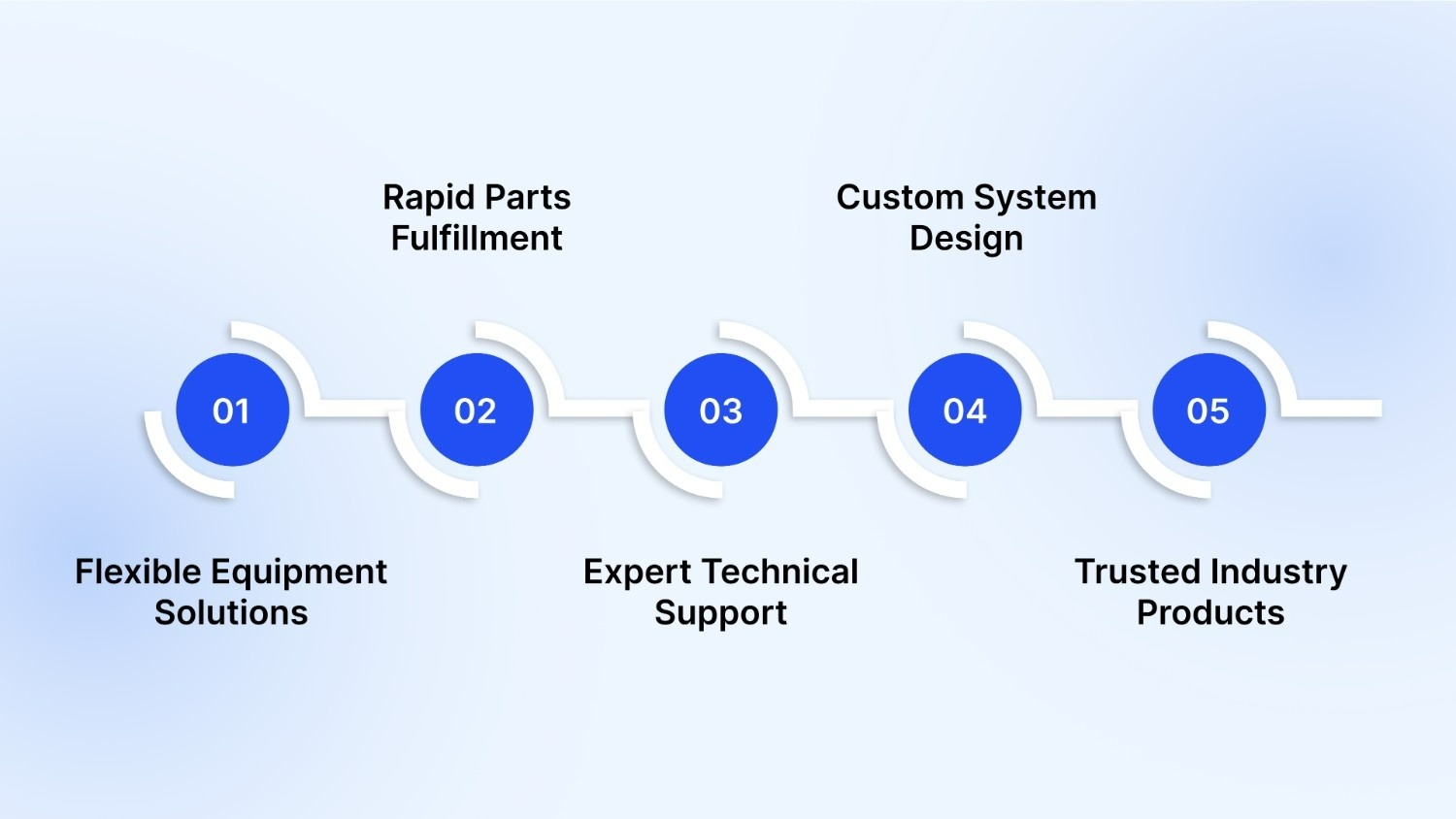
Here’s how we can help:
- Flexible Equipment Solutions: We offer options to purchase, lease, or rent packaging machines, allowing you to access the right equipment without large upfront investments. This flexibility ensures your production lines stay operational while optimizing capital expenditure.
- Rapid Parts Fulfillment: With over 2,500 SKUs in stock, our large distribution center enables 24-hour shipping for consumables, replacement parts, and essential components. Quick access to quality parts minimizes downtime and keeps machines running smoothly.
- Expert Technical Support: Our factory-trained technicians provide professional installation, preventive maintenance, and 24-hour emergency repairs. This ensures that your machines operate at peak performance and that any issues are resolved quickly and accurately.
- Custom System Design: We design integrated, ergonomic packaging solutions tailored to your workflow. From conveyors and case sealers to palletizing systems, our experts optimize your setup for efficiency, safety, and longevity.
- Trusted Industry Products: We supply only high-quality equipment and consumables from reputable manufacturers, ensuring compatibility, reliability, and compliance with industry standards.
By leveraging our expertise, businesses can proactively maintain their packaging lines, minimize downtime, and ensure equipment longevity.
Final Thoughts
Extending the lifespan of packaging machines requires a proactive, systematic approach that combines preventive maintenance, operator training, high-quality parts, smart monitoring, and environmental controls. By implementing these strategies, industrial professionals can minimize downtime, maintain product quality, and optimize operational costs.
Adopting a proactive maintenance mindset is essential. Partnering with a reliable distributor like John Maye Manufacturing further ensures that your equipment remains in optimal condition, safeguarding your investment and enhancing overall productivity.
Request a custom consultation today to explore how we can help your packaging lines perform at their best.
FAQs
1. What is the useful life of a packaging machine?
The useful life of a packaging machine depends on its type, usage, and maintenance. Generally, well-maintained machines last 10–20 years, but frequent use or harsh conditions may reduce this. Regular servicing and quality parts can extend operational lifespan.
2. How does a packaging machine work?
A packaging machine automates the process of filling, sealing, and preparing products for distribution. It typically measures, dispenses, and seals materials into containers or packages efficiently, reducing manual labour, ensuring consistency, and improving speed and accuracy in production lines.
3. What is the difference between a packing machine and a packaging machine?
A packing machine focuses on enclosing products in simple containers or bags. A packaging machine, however, handles the full process, including weighing, sealing, labelling, and protecting products, providing a complete, market-ready solution beyond just basic packing.
4. How to calculate the useful life of a machine?
Useful life is calculated by considering purchase cost, estimated maintenance, expected wear, and residual value. Methods like straight-line depreciation or manufacturer guidelines help estimate the operational duration during which the machine remains productive and cost-effective.
5. What are the three methods of packaging?
The three main packaging methods are primary, secondary, and tertiary. Primary packaging directly contacts the product, secondary groups primary packages for display or transport, and tertiary packaging is used for bulk shipping and handling, ensuring protection during transit and storage.
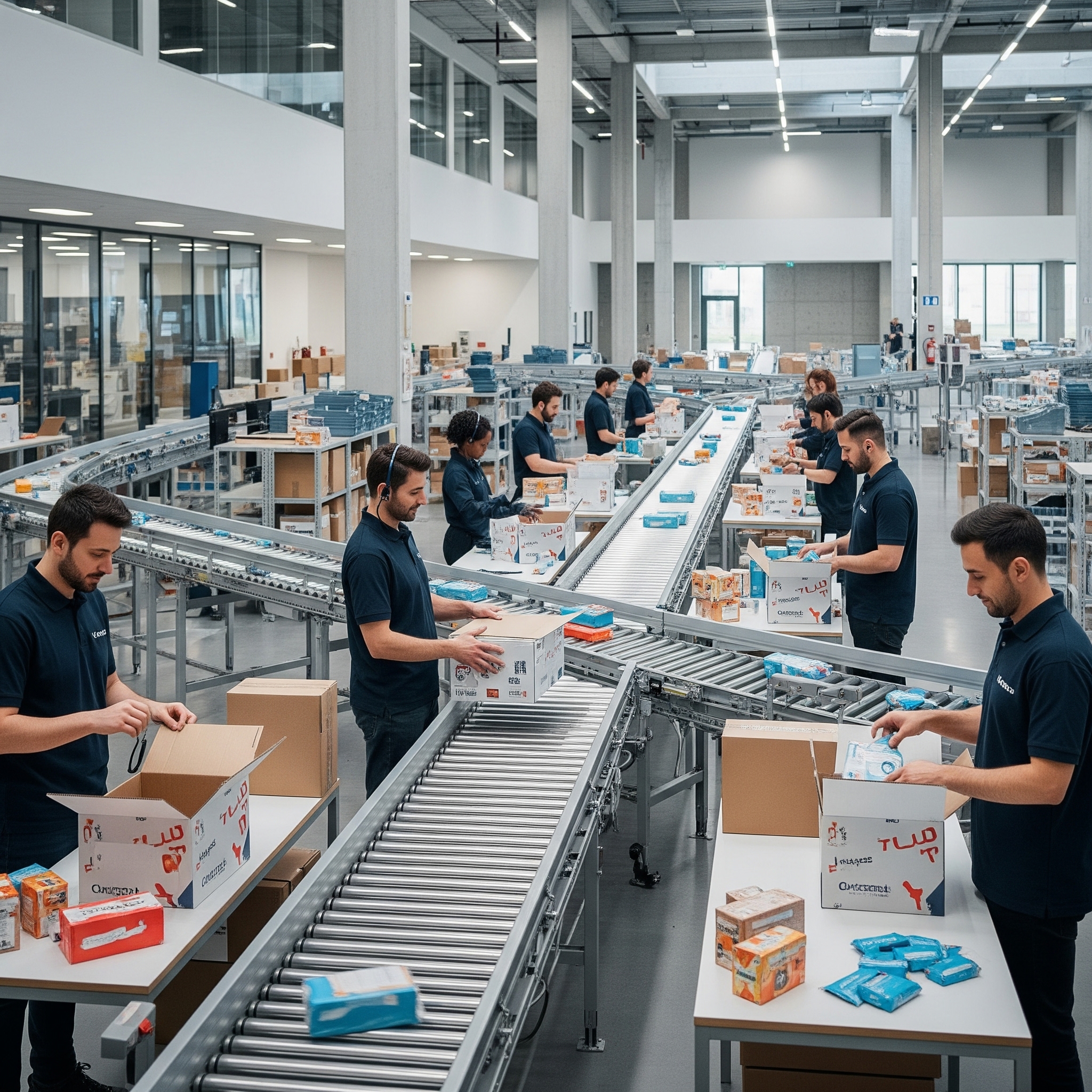
Blogs
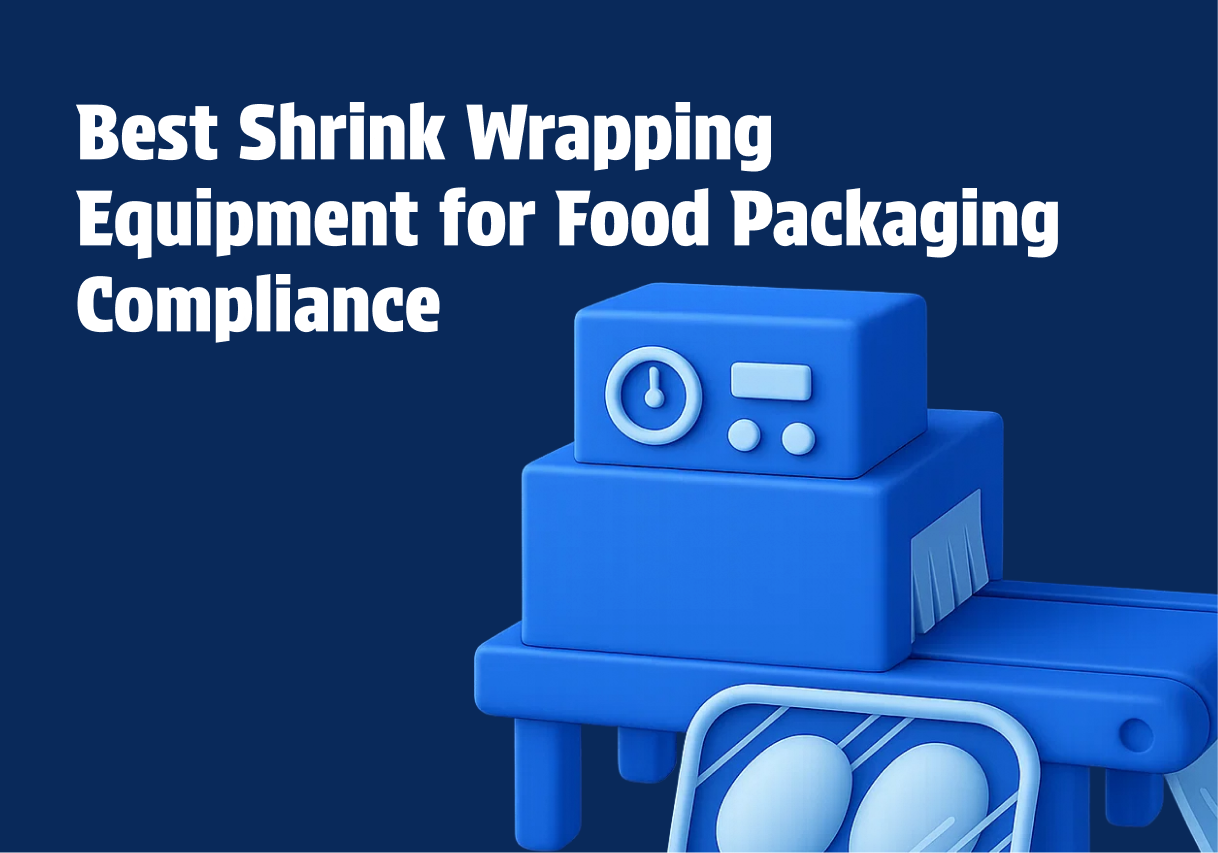
Best Shrink Wrap Machines for Your Business
Discover the best shrink wrapping equipment for food packaging compliance. Conflex offers high automation. Increase efficiency now!
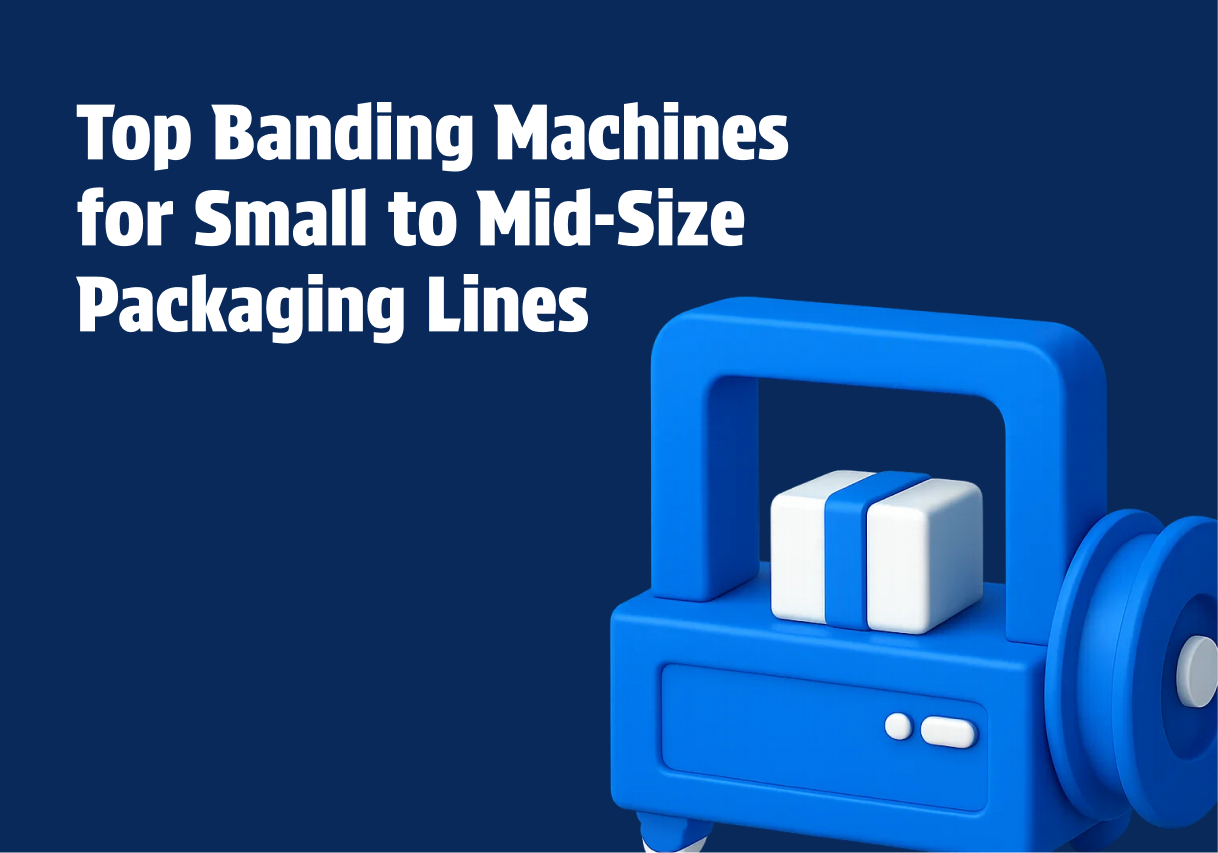
Top Banding Machines for Packaging Solutions
Find top banding machines for small to mid-size packaging lines! Discover flexible automation options and sustainability features. Optimize efficiency today!
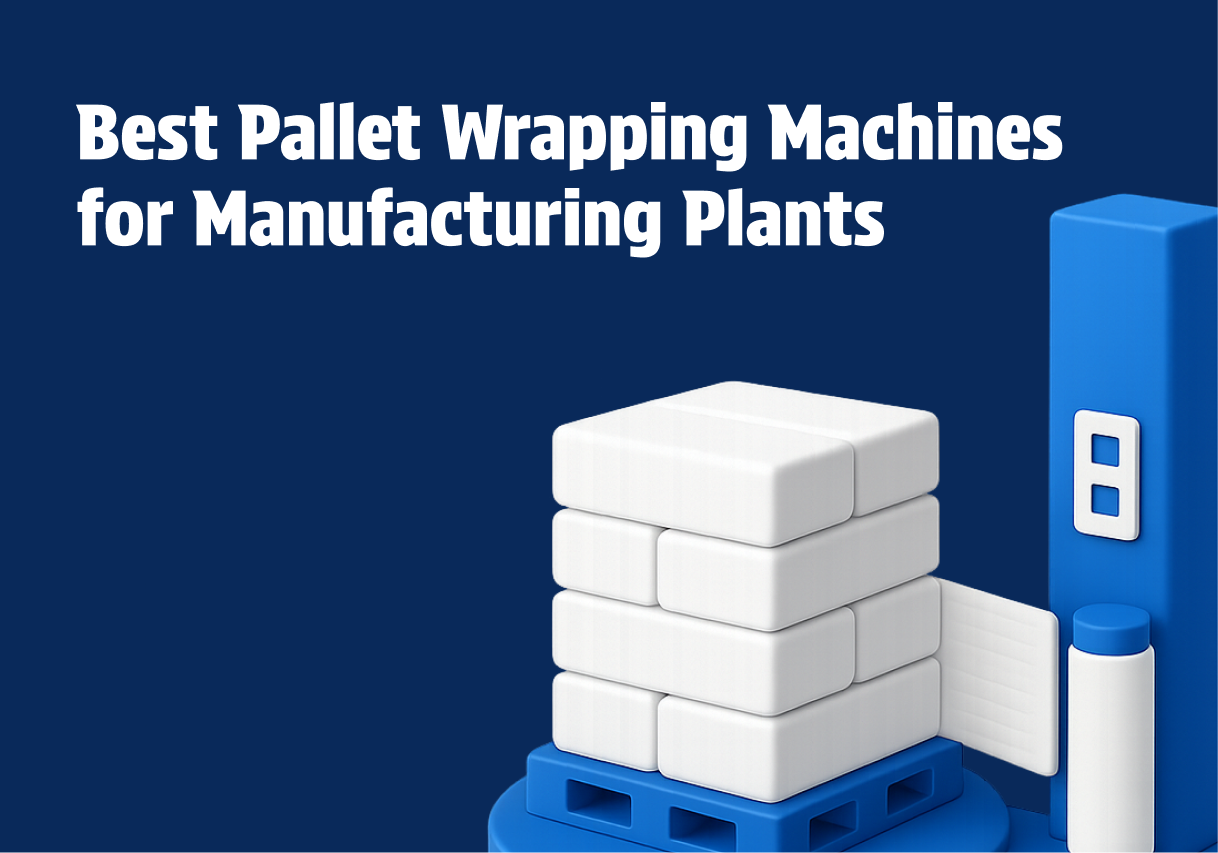
Best Pallet Wrapping Machines for Manufacturing Plants 2025
Explore the best pallet wrapping machines for manufacturing plants in 2025. Learn how to choose, compare key models, and reduce wrapping costs.
